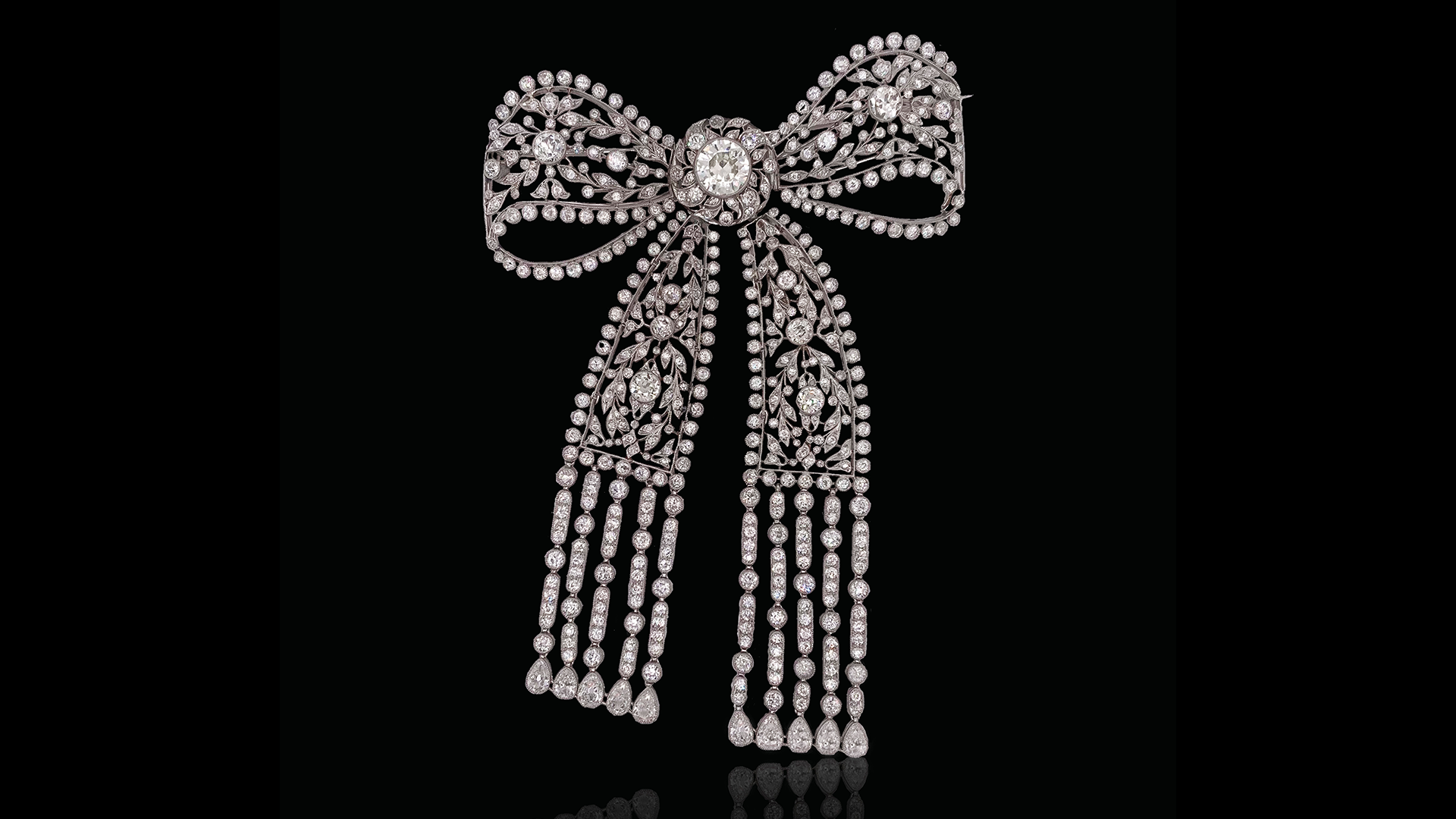Diamond and Platinum Edwardian Era Bow Brooch, Photo Courtesy: Paul Fisher, Inc.
Opulent, Refined, Luxurious, Lifestyles of the Rich and Royal, White, Platinum, Pearls, Diamonds all defined the Edwardian era.
WHEN: 1901-1915, the Edwardian era officially began during the reign of King Edward VII in 1901 (although he was coronated in 1902) and ended with the start of World War I in 1914/1915, historians vary as to the exact dates. Edward, the son of Queen Victoria, began to take on many official duties after Prince Albert, the Queen’s husband and Edward’s father, died. The Edwardian style began to develop in the late 1800s and blossomed during his reign. Even though this same time period was known as the Belle Epoque in other parts of Europe and as the Gilded Age in the United States, the jewelry had the same design aesthetic.
FAMOUS MAKERS: Boucheron, Cartier, Chaumet, Fabergé, Garrads, LaCloche, Marcus & Co., Tiffany & Co.
MOTIFS: Bows, Ribbons, Garlands, Laurel Wreaths, Florals, Feathers and Tassels, Stars, Millegrain
THE LOOK: White-on-white platinum with pearls and/or diamonds, light and lacy, intricate, formal and regal
MATERIALS: Platinum, Pearls, Diamonds, Pink Topaz, Peridot, Demantoid Garnet, Amethyst, Turquoise, Blue Sapphire, Ruby , Emerald, Aquamarine, Kunzite, Opal, Moonstone and Alexandrite
King Edward was known for his love of luxury and revelry. There were many parties and celebrations during his reign and dressing up was required. Not just dressing up to look good, but dressing up to show your rank in society and your respect for the rank of those around you.
Status-conscious Edwardians were not shy about piling on jewelry. If you want to see layering at its best, look at women of the Edwardian era. They started with a choker or dog collar and then added more necklaces of varying lengths that dropped to the waist, or longer. The dog collar was particularly popular as Edward’s wife Queen Alexandra favored the style to hide a scar on her neck and others followed suit.
Brooches and pins were also popular, with fashionable Edwardians wearing numerous pins during the day on their bodice, as epaulets and in their hair. It was also customary to wear a few bracelets stacked together on each arm along with several rings.
For an evening event, along with all the other jewelry, tiara’s, jeweled combs or other hair ornaments were worn. Tiara’s were especially important if royalty (king, queen, prince or princess), or upper echelon nobility was present. And for evening, bigger brooches were worn, often a few at a time, with star motifs being favored.
There were a number of technological events in the Edwardian era and two that made a big impact on jewelry and fashion. In 1903, the high heat oxyacetylene torch was invented. The torch was able to easily heat platinum to its melting point, allowing jewelers to stretch the metal until it became very thin. Platinum, which is a very strong metal was then formed into delicate, but very elaborate settings. It was also pierced to create openwork adding to the lightness of the pieces both aesthetically and in terms of weight. Jewelry created in the Edwardian era is surprisingly light weight given its larger sizes.
A second major technical advancement was availability of electricity. It made a big change in fashion. Heavy fabrics, brocades and velvets in dark colors that were beautiful by candlelight looked dreary and drab under electric lights. They were replaced by pastel colors and lighter fabrics such as silk or taffeta. These new styles were the perfect backdrop for the intricate, openwork jewelry of the era.
Diamonds and pearls were two of the most used gems in Edwardian jewelry. Set in platinum they reinforced the era’s formal white-on-white design aesthetic. The diamond mines in South Africa were producing an abundant supply of diamonds making them readily available and cost effective to use in jewelry design.
Pearls on the other hand were much more rare as cultured pearls had not yet been perfected and brought to market. Pearls were natural and much harder to come by making them scarce and far more valuable than other gems.
When World War I erupted, the gracious and luxurious lifestyle of the Edwardian era came to an abrupt end.
Authored by Amber Michelle
